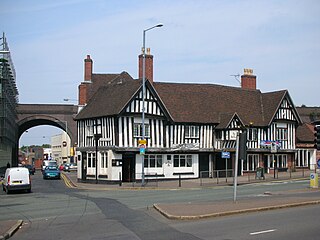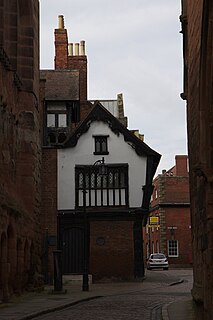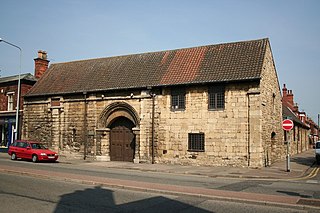
Guildhall is a municipal building in the Moorgate area of the City of London, England. It is situated off Gresham and Basinghall streets, in the wards of Bassishaw and Cheap. The building has been used as a town hall for several hundred years, and is still the ceremonial and administrative centre of the City of London and its Corporation. It should not be confused with London's City Hall, the administrative centre for Greater London. The term "Guildhall" refers both to the whole building and to its main room, which is a medieval great hall. The nearest London Underground stations are Bank, St Paul's and Moorgate. It is a Grade I-listed building.

Boston Guildhall is a former municipal building in Boston, Lincolnshire. It currently serves as a local museum and also as a venue for civil ceremonies and private functions. It is a Grade I listed building.

The Abbey of St Mary is a ruined Benedictine abbey in York, England and a Grade I listed building.

This article is about the history of Coventry, a city in the West Midlands, England.

The Old Crown, a pub in Deritend, claims to be one of the oldest extant secular buildings in Birmingham, England. It is Grade II* listed, and claims to date back to c. 1368, retaining its "black and white" timber frame, although almost all of the present building dates from the early 16th century.

A guildhall is either a town hall, or a building historically used by guilds for meetings and other purposes, in which sense it can also be spelled as "guild hall" and may also be called a "guild house". It is also the official or colloquial name for many of these specific buildings, many of which are now museums.

The Lord Leycester Hospital is one of the best preserved examples of medieval courtyard architecture in England and is a charity supporting ex-servicemen. It is located in Warwick, England, next to the West Gate, on High Street. It is a Grade I listed building. The Hospital is a prominent and internationally famous feature of Warwick. For almost 900 years buildings have been erected and civic activity has taken place on the site, starting with the chapel built in 1126. The site was donated by the 12th Earl of Warwick in the 14th century to the United Guild of the Holy Trinity and St George. The Guild Hall, Great Hall and Master's House were constructed in the late 15th century. Over the centuries, the ancient buildings and 500 year old gardens have been admired by many famous visitors such as Charles Dickens and Oscar Wilde, by Kings and Queens, such as King George V and the Queen Mother and ordinary travellers from around the world.

St Swithin, London Stone, was an Anglican Church in the City of London. It stood on the north side of Cannon Street, between Salters' Hall Court and St Swithin's Lane, which runs north from Cannon Street to King William Street and takes its name from the church. Of medieval origin, it was destroyed by the Great Fire of London, and rebuilt to the designs of Sir Christopher Wren. It was badly damaged by bombing during the Second World War, and the remains were demolished in 1962.

All Hallows, Honey Lane was a parish church in the City of London, England. Of medieval origin, it was destroyed in the Great Fire of London in 1666 and not rebuilt; the site became part of Honey Lane Market, which was in turn partially cleared to make way for the City of London School in the 19th century. Much of the area was destroyed during the bombing in World War II and has been redeveloped. The name Honey Lane is retained in a nearby walkway.

Coventry Cross was an important landmark in the cathedral city of Coventry, England. Standing between Cuckoo Lane and Holy Trinity Church and in the alley known as Trinity Churchyard, it was a modern version of the historic market cross, such as was common in many medieval market towns.

The buildings known as Whitefriars are the surviving fragments of a Carmelite friary founded in 1342 in Coventry, England. All that remains are the eastern cloister walk, a postern gateway in Much Park Street and the foundations of the friary church. It was initially home to a friary until the Dissolution of the Monasteries. During the 16th century it was owned by John Hales and served as King Henry VIII School, Coventry, before the school moved to St John's Hospital, Coventry. It was home to a workhouse during the 19th century. The buildings are currently used by Herbert Art Gallery and Museum, Coventry.

Exeter Guildhall on the High Street of Exeter, Devon, England has been the centre of civic government for the city for at least 600 years. Much of the fabric of the building is medieval, though the elaborate frontage was added in the 1590s and the interior was extensively restored in the 19th century. It is a Grade I listed building.

The Coventry Sallet is a 15th-century helmet now on display at Herbert Art Gallery and Museum. English sallets have been considered both rare and important.

St Mary's Hall is a municipal building in Bayley Lane in Coventry, West Midlands, England. It is a Grade I listed building.
John Bailey Shelton MBE was a British archaeologist who worked in the city of Coventry and a pioneer of rescue archaeology.

38–39 Bayley Lane is a former building, whose present-day site is accessible from the Herbert Art Gallery and Museum in Coventry, England. All that remains is the medieval undercroft, a fourteenth-century cellar that initially belonged to a wealthy merchant, who was a clothier. The undercroft is built with sandstone with a stone-ribbed vault for added security and strength. It is a Grade I listed building.

Drapers' Hall is a historic building in the Cathedral Quarter of Coventry built in 1832 by the Drapers' Company, a large trading guild in Coventry. The present building is believed to the third guildhall on the site.

The Mediaeval Stone Building is an unidentified mediaeval ruin on Much Park Street, Coventry, in the West Midlands of England. The ruin is a Grade II* listed building. The building is believed to have been built in the late 13th or early 14th century and was uncovered by a German bomb during the Coventry Blitz. The building was originally rectangular, and is made from red sandstone and one of the walls contains a single pointed arched window in one wall. The shell of the cellar remains—one of several similar cellars in Coventry city centre including those at 21–22 High Street, Coventry and 38–39 Bayley Lane—as do three of the four walls from the ground floor. However, the vault has been lost.

22 Bayley Lane is a grade II* listed building and only remaining mediaeval timber framed building in the Cathedral Quarter area of Coventry, where there were at one time a great many.

St Mary's Guildhall is a major domestic complex, indicating the highest social status, built in the part of the medieval city of Lincoln, England, known as Wigford. The Guildhall faces directly onto Lincoln High Street and stands to the north of Sibthorp Street. To the south is the late Saxon church of St Peter at Gowts. Stocker describes it as "the only survivor from the small group of the king's town houses which existed in several major towns….St Mary's Guildhall is a domestic complex on a palatial scale, indicating the highest social status, and as such is representative of a little known urban building type".




















